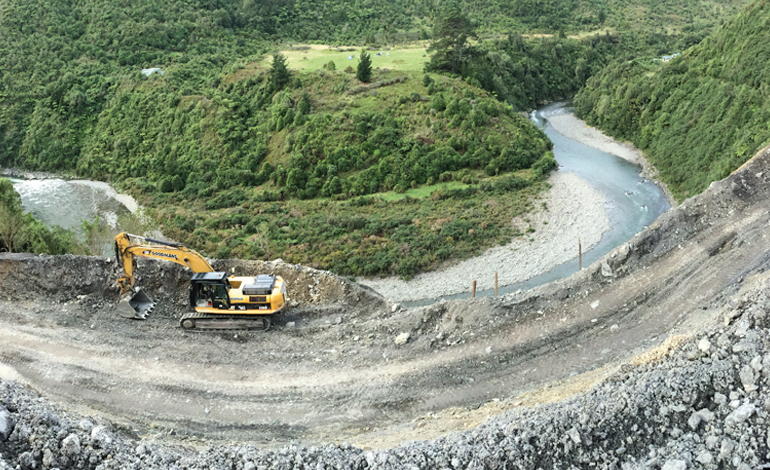This massive slip took ingenuity, logistics and careful planning to clear and stabilise. RICHARD SILCOCK reports on how working safely was paramount on the highly unstable ground conditions.
FOLLOWING A NUMBER of slips since last winter and another massive one in February this year, concerns were raised over the stability of the hillside which was displaying deep fissures some 100 metres above the popular Otaki Gorge Road which follows the Otaki River and leads to the recreational Tararua Forest Park in the lower North Island.
Large rocks and slip debris were also hanging precariously above the road necessitating the road be closed immediately for safety reasons and it has, up until recently, remained closed. It was only after extensive earthworks, stabilisation of a high bluff and over 70,000 cubic metres of debris and earth material had been removed that the road was reopened and access regained.

The Otaki River runs from its headwaters on the western side of the Tararua Ranges, through a deep gorge, out across a fertile coastal plain dotted with market gardens and orchards, to the Tasman Sea. The upper reaches of the river and park are popular with hunters, trampers, campers, recreational trout fishermen, school groups and day-trippers who gain access via the unsealed Otaki Gorge Road which follows the river through predominantly thick native bush and forest. There is a privately owned house, a DOC ranger’s house and various drop-off points along the river for kayaking and rafting operators.
Group Infrastructure Services manager with the Kapiti Coast District Council (KCDC), Sean Mallon, says the council was keen to clear the slip in an area that is known locally as the ‘Blue Bluff’ as soon as was feasibly possible to allow access for the various interested parties.
“We worked with a team of experts, including geologists, surveyors, consulting engineers and the contractor to assess what could be done in the short and long-term to stabilise the bluff, remove the slip material and restore access to the area.”
Physical works began in April, with Goodman Contracting appointed to carry out the work.

“It has been a massive job and has taken the good part of three and a half months to clear the road and stabilise the bluff face due to the enormity of the slip and the steep and difficult terrain,” says Sean. “Work included not only the removal of earth and debris, but also the cutting of wide batters into the bluff face and reducing the angle of the slope so that any future slips will be minimised.”
For Vaughan Goodman, project manager for the physical works, it was an exercise in logistics, ingenuity, communication with all parties and managing the issues associated with working safely in an extremely tight and precarious site.
“As the Otaki Gorge Road is very narrow and perched high above the river, access and safety was an issue,” says Vaughan. “We could only use relatively small equipment due to the narrow cut and unstable terrain which is weak, fractured greywacke with argillite layers through it. To compound the matter, earthquake faults also run through the area.
“Due to this and the height and steepness of the terrain, the unstable sections of the hillside were also subsiding under their own weight. To ensure very little debris ended up in the river below as we worked to remove material and create the benches we had to create an earth chute at the top of the bluff and a ‘catch-pit’ at road level. The catch-pit held around 2500 cubic metres of material which took two days to fill and one-and-a-half days to load out.

“At the top of the bluff, which was accessed by cutting through densely forested adjacent land, we were working some 200 metres above the river removing the unstable section of the bluff and cutting four, seven-metre wide benches which were at 35, 25, 25 and 25-metre intervals from the top,” he says.
“While the winter conditions were late in coming this year, heavy rain slowed construction of the batters and made handling of the material difficult. We had to carefully monitor both the slip face and the new cuttings during construction to ensure the safety of the team as further slippage was ongoing.”
Fifty-five thousand cubic metres of the cut material was dump-trucked to a nearby forestry block at Cyrus Hills for the construction of skid sites and access roads.
Once the slip material had been removed, the bluff stabilised and the batters completed, the road was graded and overlaid with standard AP40 from the Waitohu Quarry at Otaki. It was then layer graded and rolled. The vegetation was cut back, the weeds sprayed and three kilometres of the drainage system checked. The accesses to the benches were retained to allow for any future maintenance of the bluff.
The equipment used for the job included five excavators, one of which was a long-reach, 20-tonne Hyundai 210, three 40-tonne dumpers, a Cat D6T dozer and a grader.
“Goodman’s have done a fantastic job having been involved with this site since the first slip,” says Neil Williams, Roading Network Performance team leader with the KCDC. “We were very pleased we were able to engage a local contractor with the necessary skills, plant and knowledge of the terrain to undertake this work from design through to completion.
“Unfortunately there is no guarantee a slip will not happen again, but this work will help mitigate severe slips such as this one, and together with ongoing management of the slope we hope to reduce any future road closures. We will keep an eye on the ‘active’ area of the bluff and we are in the process of setting up a monitoring programme that’ll help ensure safe access to the forest park in the future.”
The road reopened to traffic in mid-July with the cost of the project around $500,000, with just under half of that coming from the NZ Transport Agency’s emergency works fund.


Parting words from Jeremy Sole- a final column